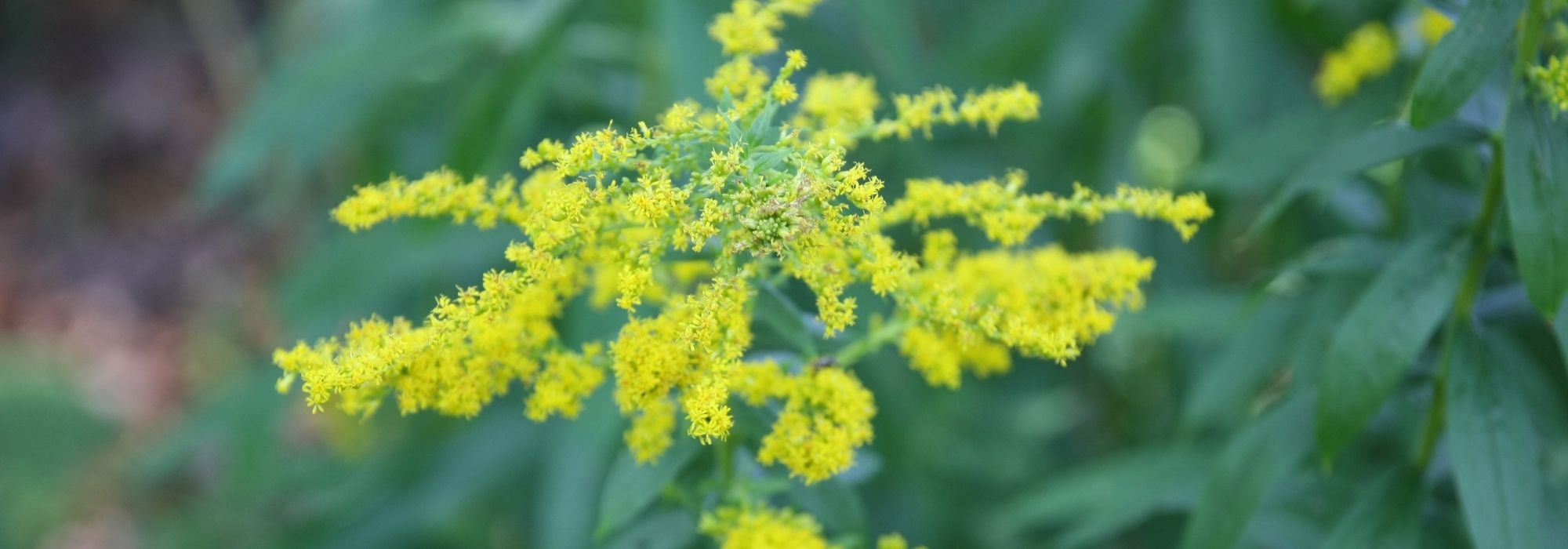
Solidago, Goldenrod: planting, growing, care
Contents
Goldenrod in a nutshell
- Floriferous and spectacular, Solidago, commonly called goldenrod, is a particularly radiant perennial that can reach up to 2 metres tall
- Its frothy golden-yellow flowering lights up every corner of the garden well into the season
- New hybrid goldenrod varieties are non-invasive and adapt to all gardens
- Very easy to grow, hardy to at least -20 °C and robust, tolerates drought and heavy soils
- One of our favourite perennials for structuring late-season natural scenes in beds, prairies or mixed borders
A word from our expert
Solidago, better known as Goldenrod, is a floriferous perennial notable for its golden-yellow flowering, as fluffy as a mimosa bouquet! Its sunlit flowers splash summer and autumn beds and borders with blazing brightness.
Aerial, feathery inflorescences of the “Gerbe d’or”, another name for Solidago, can in some species such as Solidago altissima reach two metres, while others, like Solidago ‘Goldenmosa’, remain compact at around 75 cm.
In addition to ornamental qualities, Goldenrod is also a medicinal plant, with multiple benefits, possessing diuretic and wound-healing properties; notably the species Solidago virgaurea, from which an essential oil or mother tincture is extracted and which is made into capsules or even honey!
While some Goldenrod species are now considered invasive plants, the non-invasive nature of new varieties (Solidago ‘Gold King’, Solidago ‘Crown of Ray’ syn. Solidago ‘Strahlenkrone’) means they can be used in all gardens, even the smallest.
Here is a hardy perennial (down to -20°C) and easy to grow in sun or light shade, in ordinary soil, though not too dry. Fresh, fertile soil, even clayey but well drained, will produce more abundant flowering.
With its feathery silhouette, the giant or dwarf Goldenrod is indispensable to natural gardens, to which it brings a colourful, expressive signature. In just a few years it forms handsome clumps with exceptional floribundity in brilliant shades welcome in late summer and early autumn: a boon for gardeners eager to flower their beds abundantly from summer through first frosts, without having to replant every year!
Airy and radiant, discover Goldenrod, this sturdy perennial that brings irresistible charm to the late season, with no maintenance required!
Description and botany
Botanical data
- Latin name Solidago
- Family Asteraceae
- Common name Solidago, Goldenrod, Solidage
- Flowering July to October
- Height 0.45 to 2 m
- Sun exposure Sun, partial shade
- Soil type All, fresh soil
- Hardiness -20°C
Solidago, also called solidage or goldenrod, is a herbaceous perennial belonging to family Asteraceae, like daisies, asters and sunflowers. It is native to North America, especially Canada, and to eastern and central United States where it grows in very varied habitats ranging from mountain areas to dry woods, fresh meadows, sandy fields, fallow land and riverbanks.
The genus includes about 125 species such as Solidago canadensis, or Canadian goldenrod, Solidago rugosa, Solidago gigantea or giant goldenrod. Many botanical species, now considered invasive, are increasingly abandoned (and for some banned from sale) in favour of non-invasive hybrid varieties, such as Solidago ‘Goldenmosa’, ‘Crown of Rays’ (syn. ‘Strahlenkrone’) or species with a much less invasive character, such as Solidago Shortii or Solidago altissima, a tall goldenrod. Solidago virgaurea in turn is widely used for its medicinal properties.
From a more or less running rhizomatous crown, goldenrod forms a dense upright clump, with a flexible, airy habit, sometimes slightly trailing (Solidago ‘Fireworks’) made up of numerous leafy stems from 0.30 m for dwarf forms to 2 m high in flower for the largest goldenrods such as Solidago altissima. Fast-growing, these stems can, depending on species, reach up to 1 m in a single season.
Once well established, this rhizomatous perennial grows quickly to form dense clumps that can become invasive in favourable conditions, but new varieties have moderate development making them suitable for all gardens. They usually need about two years to thicken up and reach full potential.
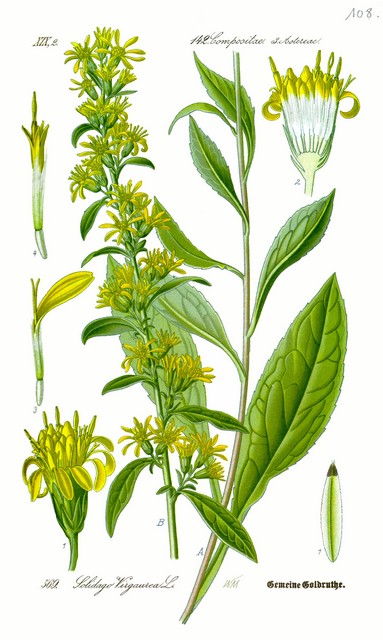
Solidago vigaurea – botanical illustration
On villous, erect stems, sometimes arching and ramified in their upper part, deciduous foliage unfolds. Leaves lanceolate to linear, with dentate margins, are arranged alternately along stems. Shiny bright green to chartreuse above, they are villous beneath and rough to the touch. Some species have stems of a reddish-purple colour.
Sunny and spectacular, flowering occurs from July to October, depending on climate and variety, bursting from fine foliage like a shower of gold. A myriad of small flowers gathered in light, arching panicles appears at tips of flexible stems. These highly ramified spikes are compact or grouped into pyramids depending on species. All bear tiny mossy heads 5 to 8 mm wide resembling miniature daisies or mimosa, made of five pedunculate lobes all bending together in same direction. They erupt in sprays often gracefully trailing in shades of pale yellow, bright lemon-yellow to golden yellow, hence vernacular name “goldenrod”!
Although unscented, this generous display rich in pollen and nectar is particularly melliferous, attracting pollinating insects right up to onset of winter.
Radiant inflorescences of goldenrods will compose wild, airy summer and autumn bouquets. They can also be dried for inclusion in dried flower arrangements.
These pollinated flowers give way to tiny winged fruits containing very many fine seeds that readily disperse by wind to self-seed where they land.
With its luminous plumes, solidago brings colour and cheer from summer to autumn and fully deserves a place in all natural gardens. Tall goldenrods such as Solidago altissima are planted at back of borders, with other vigorous perennials or on banks of a pond. Dwarf species like Solidago canadensis ‘Gold King’ are reserved for pathside or border edges.
Solidago or goldenrod is also used for centuries in phytotherapy for its medicinal virtues, notably to treat colds, respiratory and renal ailments. Used externally, goldenrod promotes wound healing, hence its Latin name meaning “to consolidate”.
Goldenrod is an edible plant; its flowers, stems and leaves, honey-flavoured, are consumed dried as infusions and herbal teas.
Read also
12 giant and imposing perennial plantsMain species and varieties
American goldenrod species (S. canadensis or Solidago canadensis, S. gigantea or giant goldenrod) are now considered invasive plants in certain regions of France and Europe, some even being banned from sale. Today, there are goldenrod varieties that are much less invasive and more compact. Dwarf or giant, Solidago come in all sizes and adapt to all gardens, even the smallest.
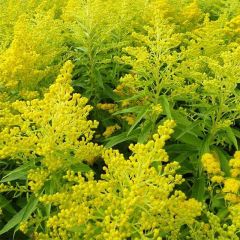
Solidago Goldenmosa
- Flowering time August to October
- Height at maturity 75 cm
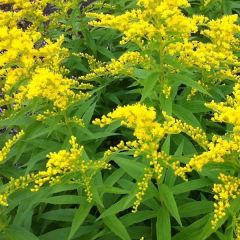
Solidago Strahlenkrone
- Flowering time August to October
- Height at maturity 75 cm
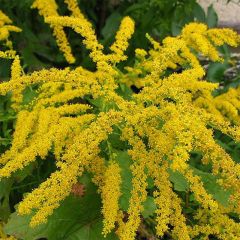
Solidago canadensis Gold King
- Flowering time August to October
- Height at maturity 75 cm
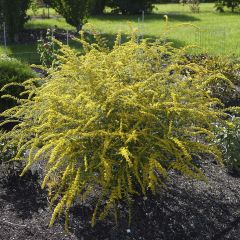
Solidago rugosa Fireworks
- Flowering time August to November
- Height at maturity 1 m
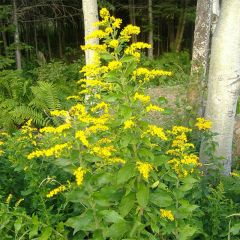
Solidago rugosa
- Flowering time September to November
- Height at maturity 90 cm
Discover other Solidago - Goldenrod
View all →Available in 1 sizes
Available in 1 sizes
Available in 1 sizes
Available in 1 sizes
Available in 2 sizes
Available in 1 sizes
Available in 1 sizes
Available in 1 sizes
Available in 1 sizes
Available in 1 sizes
Planting
Where to plant solidago?
Easy to grow and very hardy to at least -20 °C, goldenrod can be grown in all regions of France. It prefers full sun to flower well, however partial shade in southern regions is preferable. Give the tallest varieties, which can reach nearly 2 m in height, a spot sheltered from strong winds that could flatten the clumps.
Undemanding, this vigorous perennial will make do with any good garden soil, even tolerating poor or calcareous soil or occasional dryness. However, goldenrod will be more luxuriant in a cool soil, even slightly heavy or very clayey but well drained, slightly acidic. In dry ground its flowering may be less spectacular.
If recent varieties have a character that is noticeably less invasive than the botanical species, still make sure to give enough space because goldenrod tends to overshadow neighbouring plants.
An open site will encourage tall goldenrods to reach their full height.
The giant goldenrods are planted in groups in the middle or background of naturalistic beds, where they provide a vapoury relief and striking verticality. They are unmatched for structuring a large border of perennial plants or low bushes. Very graphic, they are perfect for composing rustic end-of-season scenes, full of liveliness, lightness and cheer in every corner of a natural garden, in a flowered meadow and even by the water or at the edge of a vegetable plot where they attract pollinating insects.
Dwarf or low goldenrods add interest to path edges, mixed-border and to a rockery that is not too dry.
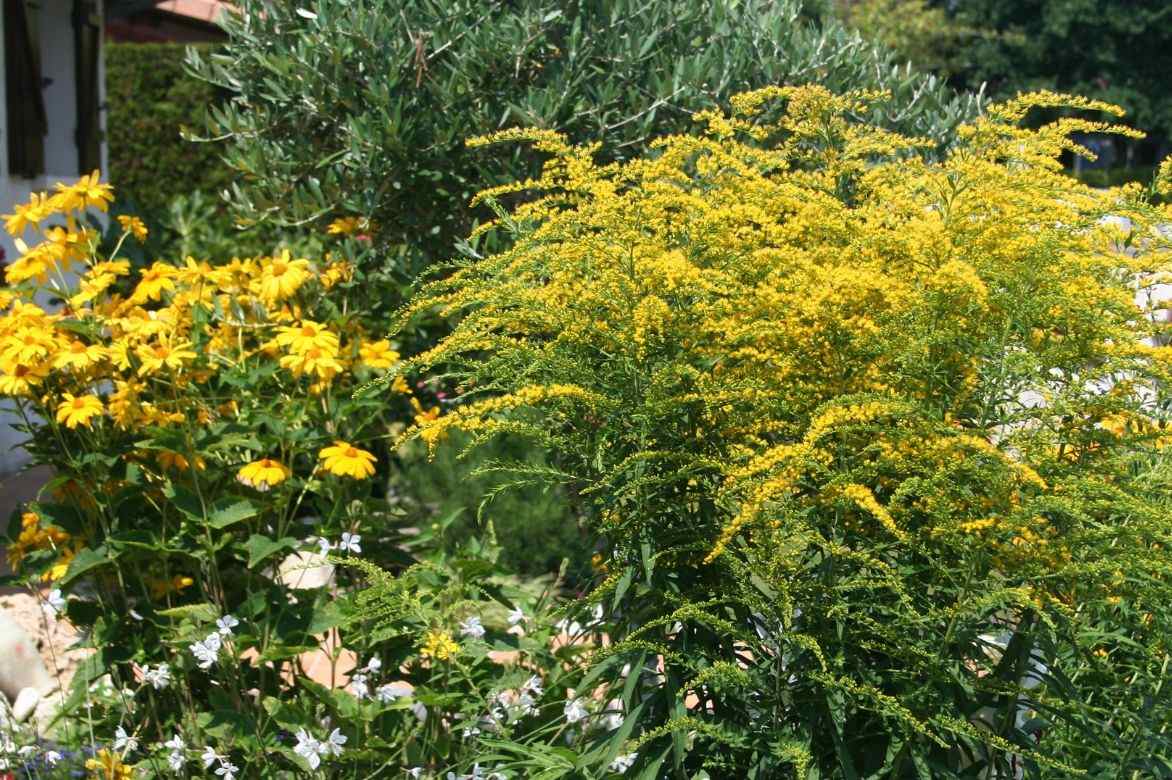
When to plant?
Planting goldenrod is done in spring, from February to April, after frosts or in autumn, from September to November, after the hot weather.
How to plant?
In open ground
If Solidago will do in ordinary well-drained soil, it will flower more abundantly in cool soil. In poor soil it will cope but will likely be less floriferous: add well-rotted compost or potting compost at planting. You can plant Solidago singly, or in groups of three plants per m2 for a dense, striking effect: space plants 30 to 80 cm apart in all directions according to mature size. Staking is sometimes necessary for large specimens.
Allow plenty of space because some species of goldenrod are quite invasive and could colonise the ground to the point of preventing other nearby plants from growing.
- Dig a hole 2 to 3 times the volume of the bucket
- Spread a layer of gravel on the bottom of the planting hole
- Add a handful or two of compost to the garden soil
- Stake if necessary
- Water regularly after planting until established
- Mulch to keep the soil cool during summer
If you do not wish to stake: plant goldenrod with other tall perennial plants and bushes, which it can lean on to prevent its flower stems collapsing at the slightest gust of wind.
And follow our tips for successful planting of your perennial plants!
In a pot
- Plant your goldenrod in a large pot of at least 7.5 litres
- Spread a good drainage layer (gravel or clay balls)
- Plant in a mixture of garden soil and good potting compost
- Add a handful of compost
- Mulch and water very regularly: this is the guarantee of a good flowering
Caring for Solidago
Once well rooted, Solidago requires little care, becoming more luxuriant year after year.
In warm regions, mulch the base during summer to keep soil sufficiently cool throughout the warm season. Water regularly, but without waterlogging the soil. It will tolerate occasional drought, provided watering remains regular.
In a pot, water more frequently without ever allowing the substrate to dry out.
Taller clumps, very susceptible to wind, will need staking, especially in windy areas.

Inflorescence faded in autumn then frosted in winter
Rather fertile soil favours its development: fertilise each year at the start of spring, incorporating compost with a light surface fork-over.
Remove faded flowers regularly to encourage flowering and to prevent excessive self-seeding.
If you wish to harvest them: cut the tops just before the flowers open and dry these bunches suspended head down away from light.
In autumn or at the end of winter, clear dead foliage and cut the dried clump back to 50 cm above soil.
If you planted a vigorous-growing species of goldenrod in spring or autumn, divide clumps to restore vigour and contain their spread.
Diseases and potential pests
Easy to grow, Solidago is largely disease-free, except perhaps powdery mildew which leaves a white coating on leaves during drought or at end of season, when weather is warm and humid. Avoid excess water that favours development of fungus, water at base of plant avoiding foliage and follow our advice to limit appearance of powdery mildew.
Solidago foliage disappears in winter, reappearing in spring, when young shoots then become target of slugs and snails. Discover our 7 ways to tackle slugs effectively and naturally and how to make a slug trap.
Propagation: Clump division
If goldenrod has a natural tendency to self-seed or to spread on its own, it can also be easily propagated by dividing the clump in spring, on mature stumps at least 3 or 4 years old.
- Using a fork or spade, gently lift the clump
- Divide off a few offsets from the periphery of the rootball
- Replant immediately in fresh, enriched, well-drained soil
Companion planting with Solidago in the garden
A reliable choice for naturalistic gardens, goldenrod is unrivalled for lightening compositions and inspiring scenes with a wild, abundant look with effortless simplicity. Its sunny tones are welcome in late summer and early autumn.
While large goldenrods structure the back of naturalistic beds, their versatile nature also allows them to add movement to borders, mixed borders or to punctuate with their tall stature the flowering meadows.
Solidago is perfect for taking over flowering between summer-flowering perennials and autumn-flowering perennials.
Planted en masse rather than alone, giant goldenrod gives substance to a bed with its intense yellow chromatic presence, which pairs easily with complementary blue or purple-flowered species such as asters, salvias, hardy geraniums, Echinops, Perovskia or a penstemon.
For a scene in explosive tones, pair it with Echinacea, Oriental poppies, daisies, agastaches, Helianthus.
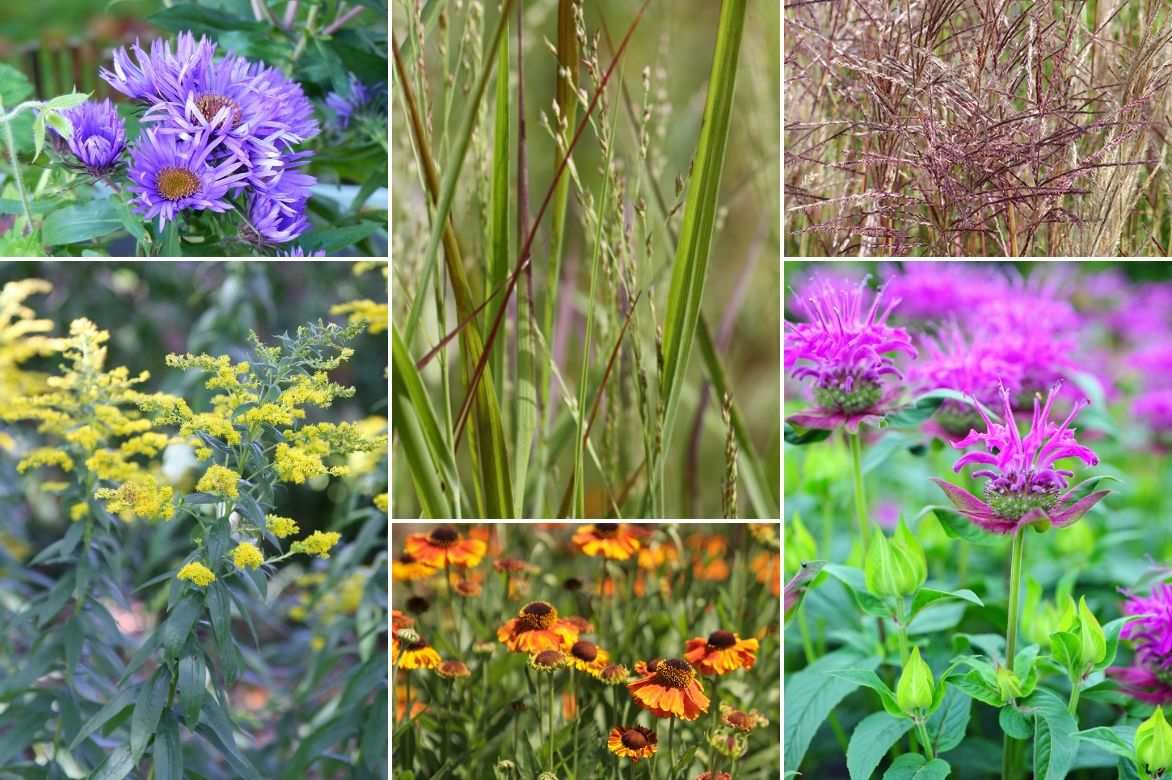
A naturalistic planting idea : Aster novae-angliae ‘Purple Dome’ (or ‘Violetta’ taller or a mix with ‘Little Carlow’), Solidago (altissima at back of bed or ‘Gold King’ or rugosa), Panicum virgatum ‘Shenandoah’, Helenium ‘Sahin’s Early Flowerer’ (and/or Helenium ‘Rubinzwerg’), Miscanthus sinensis ‘China’, and Monarda ‘Scorpion’… you can also add kniphofias, cannas…
Its loose habit will offer a shape contrast with plants equally high in colour but with more defined outlines such as dahlias, kniphofias, cannas, calmed by light grasses (Miscanthus).
In a bed dominated by yellow tones, its presence is essential alongside golden tansy, helenias, rudbeckias and achilleas, while grey or bluish foliage will temper the effect, such as artemisias, santolinas, stachys, hostas and blue fescues.
On the edge of the bed, smaller goldenrods will work wonders alongside coreopsis, small daylilies and leucanthemums.
A living mulch made of ground-cover perennials such as heucheras, periwinkles or bugle or of annual flowers such as nasturtiums and marigolds will keep freshness at its base.
To accompany summer’s last displays right up to winter’s threshold, the bright yellow of its spikes will resonate with perennial flowers in fiery hues such as Helenium, perennial chrysanthemums or autumn daisies and with annuals such as bidens, calendula or lantanas.
Goldenrods will enhance all warm tones planted at the feet of bushes with colourful autumn foliage such as deciduous spindle, purple oak, Parrotia or Cotinus.
Useful resources
- Planting perennials properly is easy with our planting guide
- Tone down yellow flowers in garden
- Subscribe!
- Contents
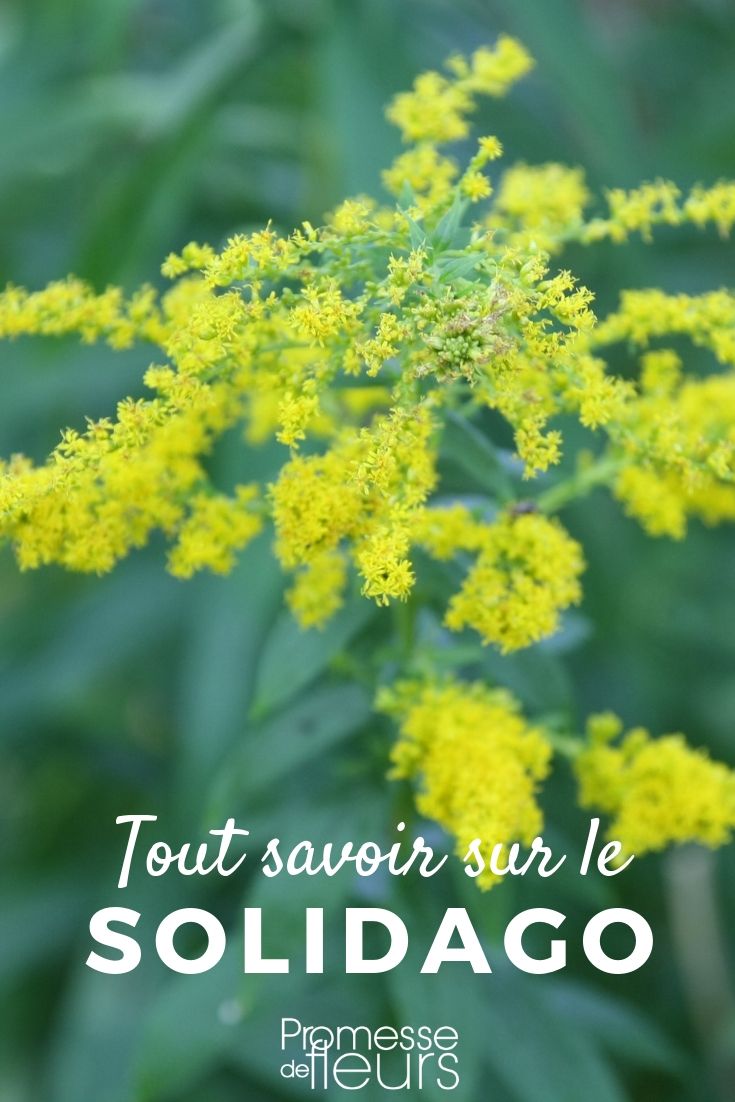
































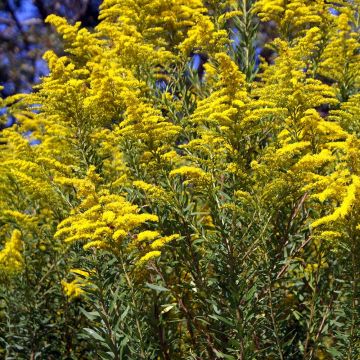
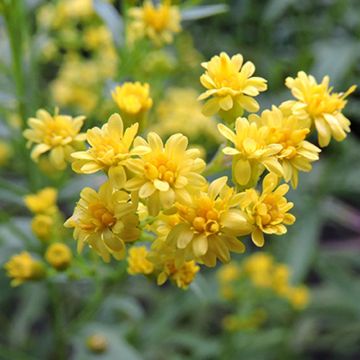


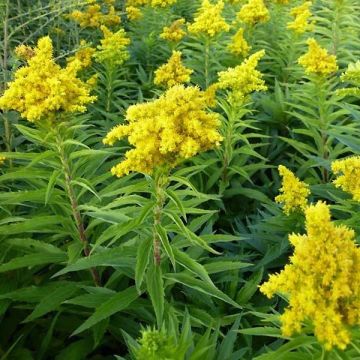
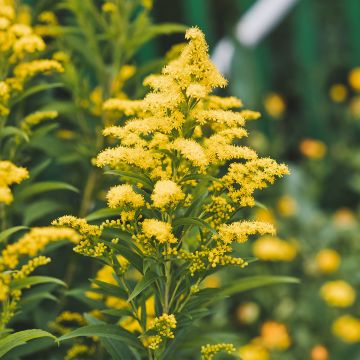
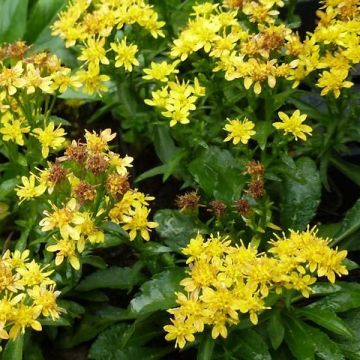

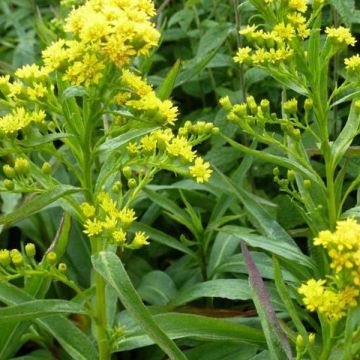
Comments